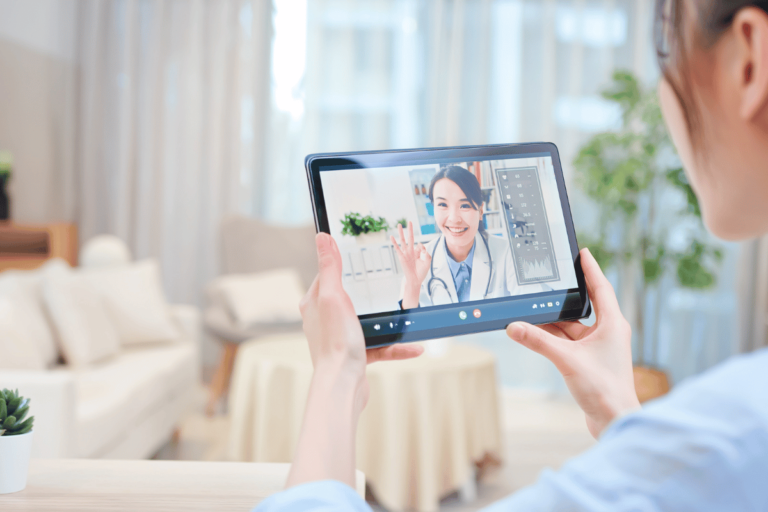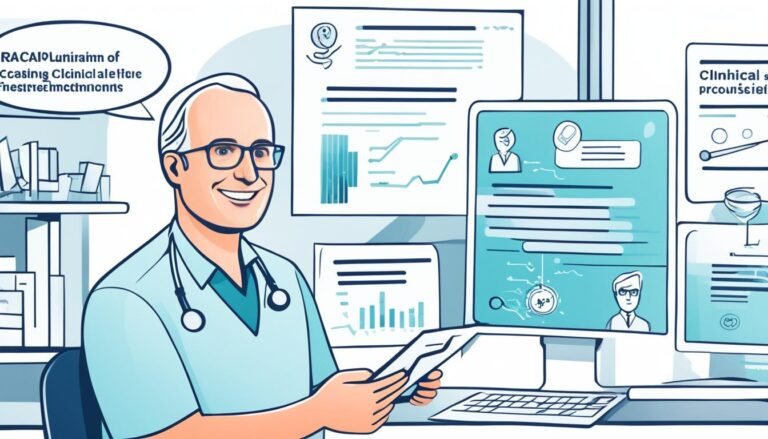Educating Patients About Wearables and Remote Monitoring Technologies
In the ever-evolving landscape of healthcare, wearables and remote monitoring technologies have emerged as powerful tools, acting as a compass guiding patients towards better health outcomes.
Like beacons of knowledge, these devices offer a unique opportunity for patients to actively participate in managing their health.
This article aims to educate patients about the benefits, workings, and potential risks of wearables and remote monitoring technologies.
By shedding light on these topics, patients can make informed decisions and maximize the potential of these transformative technologies.
Key Takeaways
- Wearables and remote monitoring technologies offer improved healthcare experience and outcomes.
- These technologies allow for continuous monitoring of health parameters and tracking progress.
- They enable remote monitoring by healthcare professionals, leading to timely interventions and personalized care.
- Wearable devices provide accurate health tracking, early detection of health issues, personalized recommendations, increased patient engagement, and improved communication with healthcare providers.
The Benefits of Wearables and Remote Monitoring Technologies
Incorporating wearables and remote monitoring technologies offers numerous advantages for patients, improving their overall healthcare experience and outcomes. With the rise of wearable technology trends, patients now have access to a wide range of devices that can monitor their health and provide valuable data to healthcare providers. These devices, such as fitness trackers, smartwatches, and even smart clothing, allow individuals to track various aspects of their health, including heart rate, sleep patterns, and physical activity levels.
This data can then be shared with healthcare professionals, enabling them to gain insights into a patient’s health status and make more informed decisions regarding their care.
One of the main benefits of wearables and remote monitoring technologies is the ability to detect and prevent health issues before they escalate. For example, wearable devices can alert individuals to any irregularities in their heart rate, enabling them to seek medical attention promptly. This early detection can significantly improve patient outcomes, as it allows for timely intervention and treatment.
Furthermore, wearables and remote monitoring technologies promote patient engagement and empowerment. By actively monitoring their health, individuals become more involved in their own care and are encouraged to make healthier lifestyle choices. This increased engagement can lead to better adherence to treatment plans, improved self-management of chronic conditions, and ultimately, better overall health outcomes.
Understanding How Wearables and Remote Monitoring Work
Understanding how wearables and remote monitoring technologies work is essential for patients to fully grasp their benefits.
Wearables provide numerous advantages by continuously monitoring various health parameters, such as heart rate, sleep patterns, and physical activity levels. This allows individuals to track their progress and make informed decisions about their health.
Remote monitoring, on the other hand, enables healthcare professionals to remotely monitor patients’ health data. This allows for timely interventions and personalized care.
Wearable Benefits Explained
Wearable devices and remote monitoring technologies offer numerous benefits to patients in terms of improved health management and enhanced healthcare outcomes. These benefits include:
-
Accurate health tracking: Wearables use advanced sensors to monitor vital signs such as heart rate, sleep patterns, and activity levels. This data is then analyzed to provide users with valuable insights into their health.
-
Early detection of health issues: Wearables can detect abnormalities in vital signs and alert users to seek medical attention. This early detection can lead to timely interventions and better health outcomes.
-
Personalized health recommendations: Through wearable data analysis, these devices can provide personalized recommendations for exercise, diet, and lifestyle modifications based on the user’s health data.
-
Increased patient engagement: Wearables encourage users to take an active role in their health by providing real-time feedback and motivation to achieve health goals.
-
Improved communication with healthcare providers: Remote monitoring technologies enable healthcare providers to remotely monitor patients’ health, allowing for timely interventions and reducing the need for in-person visits.
Remote Monitoring Advantages
With remote monitoring technologies, healthcare providers can monitor patients remotely, allowing for efficient data collection and timely interventions. Remote monitoring offers several advantages that can greatly benefit both patients and healthcare providers.
One of the key advantages is the effectiveness of remote monitoring in improving patient outcomes. By continuously monitoring patients’ vital signs and other health parameters, healthcare providers can detect and address any potential issues in real-time, leading to early interventions and better treatment outcomes.
Furthermore, remote monitoring eliminates the need for frequent hospital visits, reducing the burden on patients and improving their overall convenience and quality of life.
However, the implementation of remote monitoring can also present challenges. These challenges include ensuring the security and privacy of patient data, integrating remote monitoring systems into existing healthcare workflows, and addressing issues related to patient compliance and engagement.
Despite these challenges, remote monitoring holds great promise in revolutionizing healthcare delivery and improving patient care.
Working Mechanism Simplified
Healthcare providers can monitor patients remotely by utilizing wearables and remote monitoring technologies, which enable the collection of real-time data and timely interventions.
Here is a simplified understanding of how these technologies work:
-
Wearables: These devices, such as smartwatches or fitness trackers, are worn by the patients and can collect various health-related data, including heart rate, activity levels, and sleep patterns.
-
Sensors: Wearables are equipped with sensors that measure and record the data. These sensors can detect changes in vital signs, movements, or even environmental factors.
-
Data transmission: The collected data is then transmitted wirelessly to a centralized system, usually through Bluetooth or Wi-Fi.
-
Cloud storage: The data is securely stored in the cloud, ensuring accessibility for healthcare providers and enabling real-time monitoring.
-
Data analysis: Healthcare professionals can analyze the data to gain insights into the patient’s health status and identify any potential issues or trends.
Choosing the Right Wearable Device for Your Health Needs
When considering wearable devices for your health needs, it is important to carefully evaluate and compare at least three different options before making a decision.
With the wide variety of wearable devices available in the market today, it can be overwhelming to choose the right one. However, by considering a few key factors, you can ensure that you select a device that meets your specific health requirements.
Firstly, personalized recommendations are crucial when choosing a wearable device. Seek advice from healthcare professionals or experts who can guide you based on your medical history and current health condition. They can recommend devices that are best suited for your needs, whether it’s tracking your heart rate, monitoring sleep patterns, or managing chronic conditions.
Secondly, opt for a wearable device with a user-friendly interface. The device should be easy to navigate and understand, allowing you to access and interpret your health data effortlessly. Look for devices with clear displays, intuitive controls, and simple syncing capabilities with your smartphone or computer.
Lastly, consider the compatibility of the device with your lifestyle. If you enjoy swimming or other water-based activities, ensure that the wearable device is waterproof. If you prefer a discreet option, choose a device that can be worn inconspicuously, such as a smart ring or a clip-on tracker.
How to Set Up and Use Wearables and Remote Monitoring Devices
To successfully set up and utilize wearables and remote monitoring devices, it is essential to carefully follow the manufacturer’s instructions and ensure proper device compatibility. Here are some steps to help you get started:
-
Charge the device: Before using your wearable, make sure to charge it fully. Most wearables come with a charging cable that you can connect to a power source.
-
Download the app: Many wearables require a companion app to connect to your smartphone or tablet. Download the app from the manufacturer’s website or your device’s app store.
-
Pair the device: Open the app and follow the instructions to pair your wearable with your smartphone or tablet. This step usually involves turning on Bluetooth and selecting the device from the app.
-
Set up notifications: Customize the notifications you want to receive on your wearable. This can include incoming calls, text messages, or alerts from specific apps.
-
Troubleshoot: If you encounter any issues with your wearable, consult the troubleshooting guide provided by the manufacturer. This guide will often have solutions to common problems like syncing errors or inaccurate readings.
Tracking and Managing Your Health Data With Wearables and Remote Monitoring
Tracking and managing your health data with wearables and remote monitoring is an effective way to stay informed about your well-being. This technology allows you to continuously monitor various aspects of your health, such as heart rate, sleep patterns, physical activity, and even blood pressure. By collecting and analyzing this data, wearables and remote monitoring devices can provide valuable insights into your health status and help you make informed decisions to manage your chronic conditions.
For individuals with chronic conditions, such as diabetes, heart disease, or hypertension, this technology can be especially beneficial. By tracking key health metrics, wearables and remote monitoring devices enable individuals to proactively manage their conditions. For example, a diabetic patient can monitor their blood glucose levels using a wearable device and receive real-time alerts if their levels become too high or too low. This allows them to take immediate action, such as adjusting their insulin dosage or seeking medical attention, thereby preventing potential complications.
Moreover, tracking and managing your health data with wearables and remote monitoring can also lead to improved healthcare outcomes. By providing healthcare professionals with access to accurate and up-to-date data, these devices enable them to make more informed treatment decisions. This can result in better disease management, reduced hospitalizations, and improved overall health outcomes.
Integrating Wearables and Remote Monitoring Into Your Healthcare Routine
Integrating wearables and remote monitoring into your healthcare routine can provide numerous benefits. On one hand, remote monitoring allows for continuous tracking and real-time analysis of health data, empowering patients to take a proactive approach to their well-being. However, it also comes with its own set of challenges. The use of wearables can sometimes be cumbersome and may require additional education and support to ensure accurate data collection and interpretation.
Benefits of Remote Monitoring
Remote monitoring offers numerous advantages in improving patient care and overall health outcomes. By integrating wearables and remote monitoring into healthcare routines, patients can experience the following benefits:
- Enhanced disease management: Remote monitoring allows healthcare providers to track patients’ vital signs and symptoms in real-time, enabling early detection and intervention for better disease management.
- Improved patient engagement: Wearables provide patients with the ability to actively participate in their own healthcare, promoting a sense of empowerment and self-management.
- Timely intervention: Remote monitoring enables healthcare professionals to identify potential health issues before they escalate, leading to timely intervention and preventing emergencies.
- Personalized care: By collecting continuous data through wearables, remote monitoring facilitates personalized care plans that are tailored to individual patients’ needs and preferences.
- Cost savings: Remote monitoring reduces the need for frequent hospital visits, leading to cost savings for both patients and healthcare systems.
Incorporating remote monitoring and wearables into healthcare routines can have a significant impact on patient outcomes, improving overall health and well-being.
Challenges of Wearables
One major challenge of integrating wearables and remote monitoring into your healthcare routine is the need for continuous maintenance and troubleshooting. While these technologies have immense potential to improve patient care, they are not without their limitations and risks.
Firstly, wearables and remote monitoring devices may have technical limitations. For example, the accuracy of certain sensors, such as heart rate monitors, can vary depending on factors like skin type and device placement. This can lead to inaccurate readings and potentially misleading information for healthcare professionals. Additionally, the battery life of wearables can be a concern, as frequent charging or battery replacement may be required.
Furthermore, there are privacy and security risks associated with wearables and remote monitoring. The data collected by these devices, such as personal health information, is highly sensitive and must be protected from unauthorized access or breaches. Healthcare providers and patients need to be vigilant about the security measures in place to ensure the privacy and confidentiality of this data.
Exploring the Limitations and Potential Risks of Wearables and Remote Monitoring
When considering wearables and remote monitoring technologies, it is essential to delve into the constraints and potential hazards associated with their use. While these technologies offer numerous benefits, it is important to be aware of their limitations and the risks they may pose.
Here are some key limitations and potential risks of wearables and remote monitoring:
-
Accuracy: One limitation of wearables is the potential for inaccurate data collection. These devices may not always provide precise measurements, which could lead to incorrect interpretations of health conditions.
-
Privacy and Security: Remote monitoring technologies involve transmitting sensitive health information over networks. This raises concerns about data privacy and security breaches, potentially compromising patient confidentiality.
-
Technical Issues: Wearables and remote monitoring devices can face technical glitches or malfunctions, leading to inaccurate or incomplete data. This could result in misdiagnosis or delayed treatment.
-
Reliability: The reliability of wearables and remote monitoring technologies can vary. Factors such as battery life and connectivity issues may affect the consistent monitoring of vital signs or health parameters.
-
User Engagement: Some patients may struggle to consistently use wearables or engage with remote monitoring technologies. This could limit the effectiveness of these tools in delivering continuous care.
Understanding these limitations and potential risks can help healthcare providers and patients make informed decisions about the use of wearables and remote monitoring technologies. By addressing these challenges, healthcare professionals can maximize the benefits while mitigating the potential drawbacks.
Engaging With Healthcare Professionals for Guidance on Wearables and Remote Monitoring
To gain valuable insights into the use of wearables and remote monitoring technologies, it is crucial for patients to actively engage with healthcare professionals and seek their guidance. Healthcare professionals have extensive knowledge and experience in utilizing these technologies to monitor patients’ health and enhance their overall well-being. By engaging with healthcare professionals, patients can ensure that they are using wearables and remote monitoring devices correctly and effectively.
When seeking guidance from healthcare professionals, patients can benefit from their expertise in selecting the most suitable wearable devices for their specific health needs. Healthcare professionals can provide recommendations based on the patient’s medical history, current health condition, and goals for using these technologies. They can also educate patients on how to properly use and interpret the data collected by wearables and remote monitoring devices.
Furthermore, healthcare professionals can offer valuable insights on the limitations and potential risks associated with wearables and remote monitoring technologies. They can help patients understand the importance of data privacy and security when using these devices and guide them in making informed decisions about sharing their health data with third-party applications or platforms.
Privacy and Security Considerations for Wearables and Remote Monitoring Technologies
With the rapid advancement of wearables and remote monitoring technologies, healthcare professionals must address the privacy and security concerns associated with these devices. As patients increasingly rely on wearables to monitor their health and transmit data to healthcare providers, it is crucial to ensure that this sensitive information remains protected.
To safeguard patient data, healthcare professionals should consider implementing the following measures:
-
Data encryption: Encrypting the data transmitted by wearables and remote monitoring technologies can prevent unauthorized access and protect patient privacy. By converting the data into a code that can only be deciphered with a specific key, encryption adds an extra layer of security.
-
Data breach prevention: Developing robust protocols and systems to prevent data breaches is essential. This includes implementing firewalls, secure servers, and stringent access controls. Regularly updating software and firmware to patch any vulnerabilities is also crucial in preventing potential breaches.
-
User authentication: Requiring strong user authentication methods, such as biometric verification or two-factor authentication, can help ensure that only authorized individuals can access patient data.
-
Secure transmission: Utilizing secure communication channels, such as Virtual Private Networks (VPNs) or secure messaging platforms, can protect the transmission of patient data between wearables and healthcare providers.
-
Data retention and disposal: Implementing policies and procedures for proper data retention and disposal can minimize the risk of unauthorized access to patient information. This can include securely deleting or destroying data once it is no longer needed.
Tips for Maximizing the Benefits of Wearables and Remote Monitoring
Three key tips for maximizing the benefits of wearables and remote monitoring include incorporating them into daily routines, setting specific goals, and regularly reviewing and analyzing the data collected.
By integrating wearables and remote monitoring technologies into daily routines, patients can ensure consistent and accurate data collection. Wearing the device regularly and following the recommended usage guidelines can significantly improve the efficiency of wearables. Incorporating these devices into daily activities, such as wearing them during exercise or tracking sleep patterns, allows for a comprehensive understanding of one’s health.
Setting specific goals is another crucial aspect of maximizing wearables’ efficiency and improving remote monitoring accuracy. By defining clear objectives, patients can focus on specific areas of their health that require attention. Whether it’s monitoring heart rate, tracking steps, or managing blood glucose levels, setting goals allows for meaningful tracking and progress evaluation.
Regularly reviewing and analyzing the data collected is essential for deriving meaningful insights from wearables and remote monitoring technologies. Patients should take the time to review their data, identify patterns, and make informed decisions about their health. This process helps identify areas of improvement and track progress towards achieving goals. Additionally, reviewing the data with healthcare professionals can lead to tailored recommendations and interventions based on individual health needs.
Conclusion
In conclusion, understanding the benefits, workings, and potential risks of wearables and remote monitoring technologies is crucial for patients.
By choosing the right device, setting it up correctly, and effectively managing their health data, patients can maximize the advantages of these technologies.
Engaging with healthcare professionals for guidance, considering privacy and security, and staying informed about the limitations will ensure a safe and successful use of wearables and remote monitoring devices.





